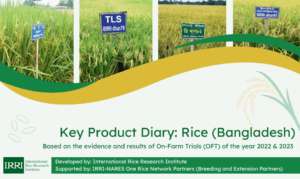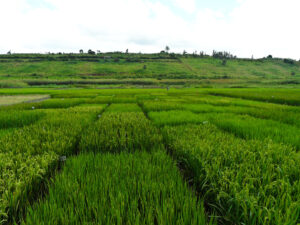Rice straw incorporation can solve environmental pollution caused by straw burning. Studies show that early incorporation is one the most cost-effective, climate-smart rice straw management options.Unfortunately, rice straw decomposition takes time.Because of the environmental impacts of straw burning and the importance of quick turnaround times between crops, there is a need to hasten the decomposition of rice straw that is incorporated into the field. Accelerating the decomposition process can promote rice straw incorporation as a preferred practice compared to burning and the application of microbial inoculants could possibly help.
Rice is one of the most important agricultural commodities in the Philippines and other parts of the world, particularly Asia. However, the production of this staple grain to feed the growing population also produces many tons of waste. In 2009, it was reported that 242, 97, 22, and 11 MT of rice straw residue were produced annually in China, India, Thailand, and the Philippines, respectively.
To eliminate this residue, one cost-effective method that is widely practiced is burning rice straw in the field. In the Philippines alone, 95% of the residue undergoes open-field burning. Rice straw burning is widely employed because it is less laborious compared to other practices such as straw incorporation into the soil. Burning can also eliminate many pathogens, and, most importantly, it results in rapid and complete residue removal.
While burning seems to be the most practical way of removing the straw, this practice has several undesirable effects including loss of major nutrients. The nutrient loss caused by straw burning can reach 80% for nitrogen (N), 25% for phosphorus (P), 21% for 33 potassium (K), and 4–60% for sulfur (S).
In addition, biomass burning is the second-largest source of trace gases and the largest source of primary fine carbonaceous particles in the global troposphere. A recent Life Cycle Assessment (LCA) of existing in-field and off-field rice straw management practices reported that rice cultivation with in-field burning is the worst option with the lowest energy efficiency and highest air pollution emission.
The use of modern farm equipment enables farmers to easily manage farm operations. For instance, the combine harvester combines harvesting operations—reaping, threshing, and winnowing into a single process. The use of combine harvesters has therefore been used for rice and has expanded rapidly worldwide and major producers, such as Vietnam and Cambodia, almost exclusively rely on them. Because of this technology, harvesting can be performed even with minimal manpower and the chopped rice straw can be incorporated into the soil for decomposition.
Rice straw incorporation can solve environmental pollution caused by straw burning. In a meta-analysis in China which compared the effects of straw burning and incorporation on the Net Global Warming Potential (NGWP) to include C sequestration, it was found that switching from burning to straw incorporation could mitigate 34.18 Mt. CO2 eq year−1 or 31% of total emissions in the country. Studies show that early incorporation is one the most cost-effective, climate-smart rice straw management options. High rates of straw incorporation under aerobic conditions can sequester soil organic carbon (SOC) with a minimal increase in emissions compared to incorporation under flooded conditions.
Practices that optimize SOC sequestration while minimizing emissions, such as early straw incorporation with alternate wetting and drying water management, could be an important step towards carbon–neutral rice systems. Straw incorporation has been shown to enhance nutrient recycling and provide soil fertility benefits by increasing SOC and yields of subsequent crops. The incorporated straw can also provide substrates to promote biodiversity through flourishing of invertebrates that decompose the straw, which in turn enhances nutrient cycling in paddy soils.
A recent study in Vietnam showed that the addition of rice straw improved soil pH, soil organic C, and nutrient content compared to addition of ash from burned straw. Due to the low N content in straw, however, large quantities would be needed to supply adequate amounts of N. In addition, the straw has to decompose before the nutrients can become available for uptake and the rate of decomposition and supply of nutrients depend on soil type and season. A sufficient level of decomposition is also needed for mechanized seedbed preparation to prevent clogging of seeders.
Unfortunately, rice straw decomposition takes time. In a recently reported 5-year experiment, the release of C, N, cellulose, and hemicellulose was found to occur mainly during the first and second years after straw incorporation. Moreover, the release of P and K occurred mainly during the first month, while lignin was released at various rates throughout the entire study period. Long-term incorporation of crop residues in flooded rice soil can increase soil organic matter, total N, and soil biological activity. Continuous incorporation of crop residues after each crop can eventually increase the N-supplying capacity of rice soils.
In a study in Vietnam, soil N increased from 0.65 to 0.85% following 9 years of cropping with incorporation of rice straw while straw removal caused a decline in soil N. However, the benefits of incorporated residues on soil organic matter and soil N supply seldom translate into increased yield or profit for flooded rice. The production of two or three rice crops annually also results in the production of large quantities of straw, with little turnaround time between crops. This results in limited decomposition of the straw when incorporated, with potential negative effects on nutrient availability and use efficiency of applied fertilizers for the subsequent crop.
Because of the environmental impacts of straw burning and the importance of quick turnaround times between crops, there is a need to hasten the decomposition of rice straw that is incorporated into the field. Accelerating the decomposition process can promote rice straw incorporation as a preferred practice compared to burning and the application of microbial inoculants could possibly help in doing so.
Microorganisms play a role in the decomposition process as they are the ones responsible for the conversion of crop residues to soil organic matter. Rice straw decomposition is a complex process made up of several subprocesses and involves a diversity of organisms. One of the most common rice straw-degrading microorganisms are the fungi Trichoderma. Trichoderma spp. play an important role in biological decomposition and are also known to produce cellulolytic and hemicellulolytic enzymes.
The potential of Trichoderma spp. in hastening the decomposition of straw has been previously reported. In the Philippines, the inoculation of a straw-based compost pile with Trichoderma harzianum was reported to have a composting time of less than half of the conventional methods of composting. Trichoderma spp. are also reported to be able to degrade agricultural and domestic waste relatively quickly without emitting bad odors.
This study assessed the potential of a Trichoderma-based compost activator for the enhanced decomposition of incorporated rice straw by conducting experiments under both laboratory and field conditions. Results of the laboratory experiment indicated that the inoculant could increase decomposition rates under laboratory conditions, with an average of 16% higher amounts of CO2 released compared to uninoculated straw in sterile soil samples.
These results confirmed that the Trichoderma-based compost activator can hasten the decomposition of incorporated rice straw. The increased fungal population in inoculated samples is an indication of enhanced biodiversity and the low C:N ratio promotes N mineralization.
While the improved chemical and biological properties in the incorporated straw indicated better decomposition, the changes in the physical conditions of the soil were not assessed in this study. Additional experiments may be needed to determine such properties since this information would be helpful in the field operations for the succeeding cropping period, which includes land and seedbed preparation. The use of additional amendments, such as manure and/or organic fertilizers or performing additional field operation activities, may also be tested to determine if the decomposition period can be shortened further.
Read the study:
Organo, N.D., Granada, S.M.J.M., Pineda, H.G.S. et al. (2022) Assessing the potential of a Trichoderma-based compost activator to hasten the decomposition of incorporated rice straw. Sci Rep 12, 448.






